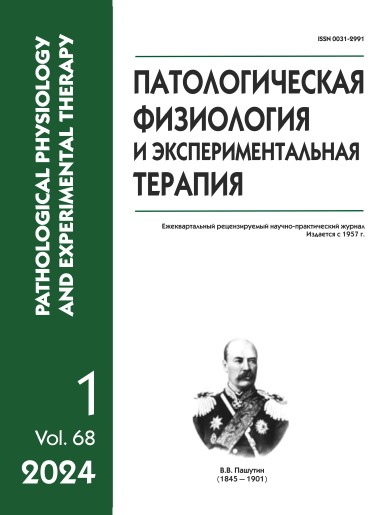Влияние фетоплацентарной недостаточности у беременных женщин при внутриутробном инфицировании на состояние здоровья новорожденных и детей раннего возраста
DOI:
https://doi.org/10.25557/0031-2991.2024.01.89-97Ключевые слова:
внутриутробное инфицирование, фетоплацентарная система, кортизол, ИЛ-6, ИЛ-10, состояние новорожденных, заболевания детей раннего возрастаАннотация
Цель работы – изучить роль кортизола и ИЛ-10 в механизме формирования фетоплацентарной недостаточности на фоне внутриутробного инфицирования, оценить состояние новорожденных и заболеваемость детей до трех лет жизни. Методика. Проведено морфологическое и гистологическое исследование последов у 205 беременных женщин высокой группы инфекционного риска. Оценивали наличие признаков восходящего, гематогенного и смешанного инфицирования последа, а также признаки острой и хронической плацентарной недостаточности. В первом и втором триместрах беременности в сыворотке крови женщин методом иммуноферментного анализа определяли концентрацию кортизола, а также ИЛ-6 и ИЛ-10. По шкале Апгар оценивали состояние новорожденного. Анализировали амбулаторные карты детей до трех лет. Анализ полученных данных проводили непараметрическими методами статистики. Результаты. В группах с восходящим и смешанным инфицированием уровень кортизола в 1 триместре беременности был статистически значимо выше относительно группы контроля (р <0,05). Низкие показатели кортизола в этих же группах сохранялись и во II триместре беременности. Концентрация ИЛ-10 в группах с восходящим и гематогенным инфицированием в сроке 11-12 недель беременности статистически значимо снижена. Обнаружена обратная корреляционна связь между уровнем кортизола и уровнем ИЛ-10 при восходящем и гематогенном инфицировании. У женщин с признаками инфицирования последа чаще встречались незрелые промежуточные ворсины, которые свидетельствует о нарушении созревания плаценты. При восходящем инфицировании последа статистически значимо чаще развивалась хроническая компенсированная недостаточность, а при смешанном инфицировании - в стадии субкомпенсации. Гипотрофия плода статистически значимо чаще встречалась при гематогенном инфицировании. Уровень заболеваемости в группах с различными путями инфицирования был статистически значимо выше в сравнении с контролем. Заключение. Полученные данные свидетельствуют о нарушении формирования фетоплацентарного комплекса при восходящем, гематогенном и смешанном путях инфицирования в связи с активацией продукции кортизола и снижения концентрации ИЛ-10 в начале гестации. Формирование ранней фетолплацентарной недостаточности на фоне внутриутробной инфекции является фактором риска заболеваемости новорожденных и детей. Дети высокой группы инфекционного риска требуют тщательного наблюдения за состоянием здоровья.Загрузки
Опубликован
2024-04-11
Выпуск
Раздел
Оригинальные исследования
Как цитировать
[1]
2024. Влияние фетоплацентарной недостаточности у беременных женщин при внутриутробном инфицировании на состояние здоровья новорожденных и детей раннего возраста. Патологическая физиология и экспериментальная терапия. 68, 1 (Apr. 2024), 89–97. DOI:https://doi.org/10.25557/0031-2991.2024.01.89-97.













